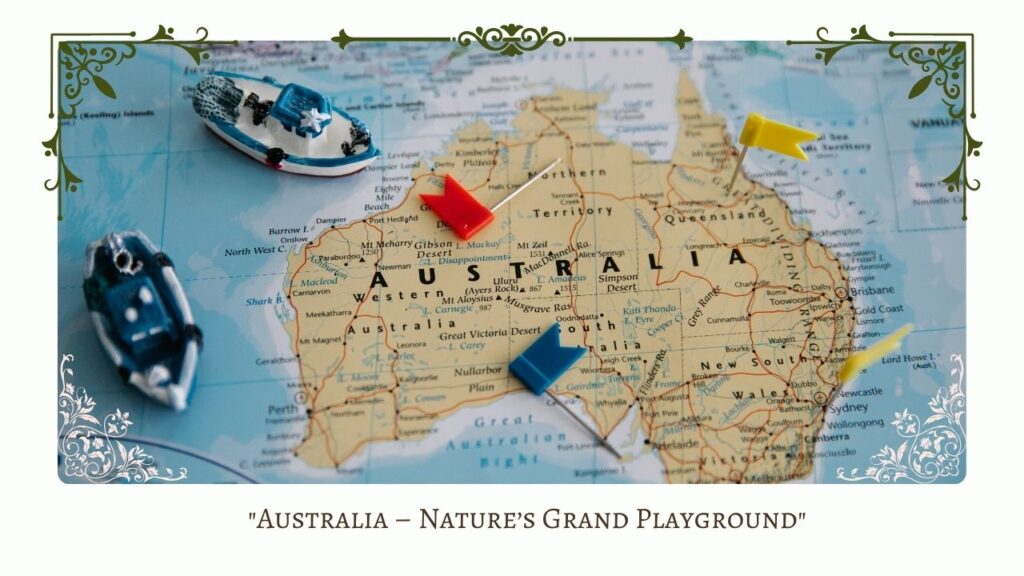Here’s a human-like, easy-to-understand introduction suitable for a Class 6 ICSE-level blog or textbook on “Australia: Land, Climate, and Natural Vegetation”:
Introduction: Australia – Land, Climate, and Natural Vegetation
Australia is a land of amazing variety. From vast deserts and rocky plateaus to green forests and fertile plains, its landscape is full of contrasts. The climate in different parts of the country also changes — some areas are hot and dry, while others get a lot of rain. Because of its location in the Southern Hemisphere, Australia’s seasons are the opposite of ours. The natural vegetation of Australia is shaped by its climate and land. You will find rainforests, grasslands, and deserts, all in one country. In this lesson, we will explore Australia’s landforms, its weather, and the unique plants that grow there.
A: Choose the Correct Option
- The southeastern part of Australia experiences → Temperate climate
- The Tropic of Capricorn passes through the middle of the continent.
- The Great Barrier Reef is made up of → Corals
- Australia has → Six self-governing states.
- The dingo is a → Carnivore
B: Fill in the Blanks
- The Commonwealth of Australia was established in the year 1901.
- Australia stretches from 10°S to 44°S latitudes.
- The largest single rock in the world is Uluru (Ayers Rock).
- Northern Australia experiences tropical climate.
- The Eucalyptus tree is also known as the gum tree.
C: Mark the Wrong Statements and Correct Them
- Australia is the world’s smallest continent. ✅ (Correct)
- The Bering Strait forms the border between Australia and New Zealand. ❌ (Wrong) → The Tasman Sea forms the border between Australia and New Zealand.
- Mount Hammersley is the highest peak in Australia. ❌ (Wrong) → Mount Kosciuszko is the highest peak in Australia.
- Melbourne has dry summers and wet winters. ❌ (Wrong) → Melbourne has variable weather, but it generally has mild summers and cool winters.
- The rose is Australia’s national flower. ❌ (Wrong) → The Golden Wattle is Australia’s national flower.
Question and Answer on Globes and Maps
Essay on The Rise of AI-Generated Art and Its Ethical Dilemma
D: Answer these questions in 10-20 words
- Who is credited with the discovery of Australia?
Captain James Cook is credited with the discovery of the eastern coast of Australia in 1770. - When was the Australia Act passed? What is its significance?
The Australia Act was passed in 1986. It gave Australia full independence from British Parliament. - What are the neighboring countries of Australia?
Australia’s neighbors include New Zealand, Indonesia, Papua New Guinea, East Timor, and the Solomon Islands. - Name the self-governing states of Australia.
New South Wales, Victoria, Queensland, South Australia, Western Australia, and Tasmania are self-governing states. - Mention two characteristic features of Uluru (Ayers Rock).
It is a huge red sandstone rock and a sacred site for the Aboriginal people. - Which is the most fertile part of Australia?
The southeastern coastal region is the most fertile and supports farming and dense population. - Where is the Great Dividing Range located?
It is located along the eastern coast of Australia, from north Queensland to Victoria. - Seasons in Australia are exactly opposite to those of ours. Why?
Australia lies in the Southern Hemisphere, so its seasons are opposite to those in the Northern Hemisphere. - What type of vegetation is found in the Mediterranean climatic region of Australia?
Shrubs, short trees, and hardy plants that can survive dry summers and mild, wet winters are found. - What are marsupials?
Marsupials are animals that carry and feed their young ones in pouches, like kangaroos and koalas.

E. Answer these questions in 50–60 words
- What are the characteristic features of the Western Plateau of Australia?
The Western Plateau is a large, flat, and dry area. It has deserts, rocky land, and few rivers. This region gets very little rain and has high temperatures. It also has many old rocks and is rich in minerals like iron and gold. - How do latitude and the direction of mountains affect the climate of Australia?
Australia lies in the Southern Hemisphere, mostly in tropical and temperate zones, which affects its climate. The Eastern Highlands block rain from reaching the inland areas. So, the eastern side gets more rain, while the central and western parts remain dry. - Compare the natural vegetation found in the tropical regions of Australia with that of the temperate regions.
Tropical regions have dense forests with tall trees and green plants due to more rain. In temperate regions, vegetation includes grasslands and small bushes. These areas have less rainfall, and the plants are suited to cooler temperatures and dry weather.
F. Answer these questions in 75–100 words
- What is the significance of the Great Artesian Basin? How is an artesian well formed?
The Great Artesian Basin is one of the largest underground water sources in the world. It is very important for dry parts of Australia. Water from the basin is brought to the surface through artesian wells. These wells are formed when underground water is trapped between rock layers. Pressure from the rocks forces the water up when a hole is drilled. This water is used for farming, drinking, and cattle. - Where is the Great Barrier Reef located? Explain its formation.
The Great Barrier Reef lies in the Coral Sea, off the northeast coast of Queensland, Australia. It is made of tiny sea creatures called corals. Over thousands of years, dead coral skeletons piled up and formed the reef. Living corals grow on top. It is the largest coral reef in the world and can even be seen from space. - Describe the various climatic types found in Australia.
Australia has different climate types. The north has a tropical climate with wet and dry seasons. The centre is mostly desert with very hot and dry weather. The southeast and southwest have temperate climates with mild summers and cool winters. The east coast has a lot of rainfall, while the inland gets very little rain. - The wildlife of Australia is unique. Justify this statement with suitable examples.
Australia has many animals and birds that are not found anywhere else in the world. Animals like the kangaroo, koala, platypus, and echidna are found only in Australia. These animals developed in special ways because Australia was separated from other continents. The island’s different climate and landforms helped in the growth of this unique wildlife.
G. Give reasons for the following
- Australia is often called “Down Under.”
Australia is located in the Southern Hemisphere, below the equator, so it is called “Down Under.” - The Lake Eyre Basin is an area of inland drainage.
Rivers in the Lake Eyre Basin do not reach the sea. They end in Lake Eyre, which dries up often. - The Great Barrier Reef is a hazard to navigation.
The reef has many sharp coral structures underwater, which can damage ships and boats, making sailing risky. - Some animals and birds found in Australia are not found in any other part of the world.
Australia’s wildlife developed separately due to its long isolation from other continents, creating animals like the kangaroo and koala.


